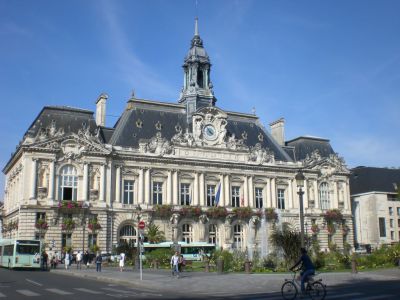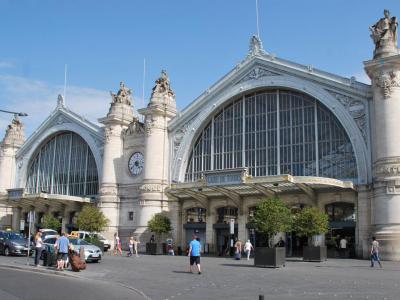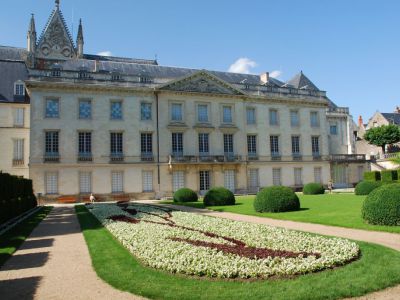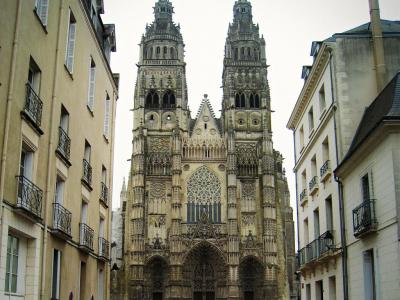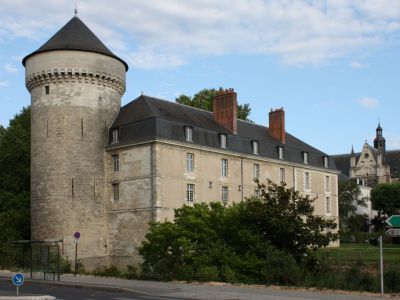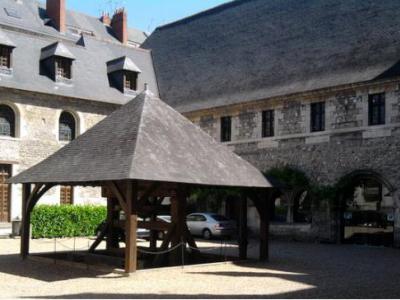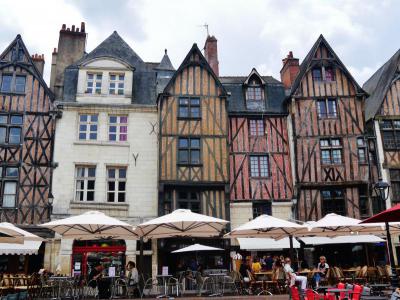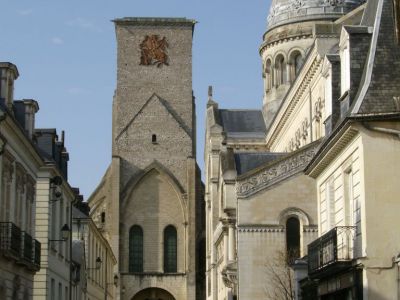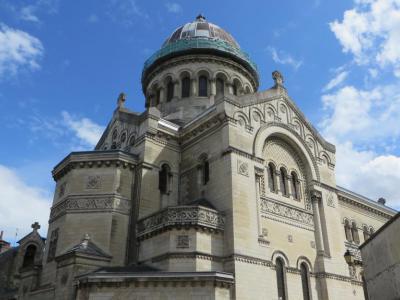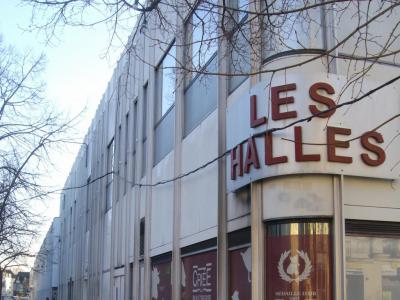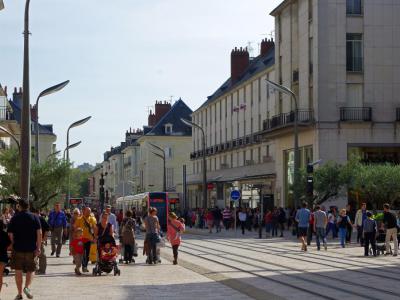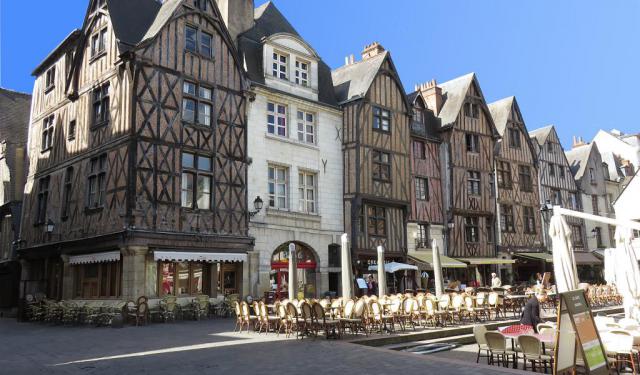Tours Introduction Walking Tour (Self Guided), Tours
The Roman Emperor Augustus named the city Caesarodunum (Hill of Caesar). But it was always Tours. Caesar left the Tours Ampitheatre, the largest amphitheater of the Empire. It's good to be Caesar.
Tours is located on the River Loire. It stands between Orleans and the Atlantic shore. It is famous for the Battle of Tours in 732 CE when Spanish Moors led by Abdul Rahman Al Ghafiqi was defeated at Poitiers by Christian army led Charles Martel. Martel's victory ensured that the rest of Europe remained Christian.
Tours has valiantly weathered it all. It is called the "White and Blue" city for the historic use of blue tiles for roofing. The White and Blue city is registered with UNESCO, and has a patrimonial site in the Old City district.
The attractions of Tours start with Tours Cathedral, dedicated to St. Gatien, the first Bishop. It was built between 1170 and 1547 to replace the previous cathedral which had burned in 1166. It is almost entirely in the Flamboyant Gothic style of the 15th century.
The Museum of Fine Arts is near to Tours Cathedral. In the courtyard there is a giant Cedar of Lebanon said to have been planted by Napoleon. In the museum, beside the collections is a stuffed elephant named "Fritz." Fritz was killed while touring with Barnum & Bailey in 1902.
In the Old City district there are medieval half-timbered buildings and the popular Place Plumereau, a square of busy pubs and restaurants. Other points of interest are The Chateau of Tours, The Basilica of St Martin, Patron Saint of Tours. The Tower of Charlemagne. There are many more, come and see.
Tours is located on the River Loire. It stands between Orleans and the Atlantic shore. It is famous for the Battle of Tours in 732 CE when Spanish Moors led by Abdul Rahman Al Ghafiqi was defeated at Poitiers by Christian army led Charles Martel. Martel's victory ensured that the rest of Europe remained Christian.
Tours has valiantly weathered it all. It is called the "White and Blue" city for the historic use of blue tiles for roofing. The White and Blue city is registered with UNESCO, and has a patrimonial site in the Old City district.
The attractions of Tours start with Tours Cathedral, dedicated to St. Gatien, the first Bishop. It was built between 1170 and 1547 to replace the previous cathedral which had burned in 1166. It is almost entirely in the Flamboyant Gothic style of the 15th century.
The Museum of Fine Arts is near to Tours Cathedral. In the courtyard there is a giant Cedar of Lebanon said to have been planted by Napoleon. In the museum, beside the collections is a stuffed elephant named "Fritz." Fritz was killed while touring with Barnum & Bailey in 1902.
In the Old City district there are medieval half-timbered buildings and the popular Place Plumereau, a square of busy pubs and restaurants. Other points of interest are The Chateau of Tours, The Basilica of St Martin, Patron Saint of Tours. The Tower of Charlemagne. There are many more, come and see.
How it works: Download the app "GPSmyCity: Walks in 1K+ Cities" from Apple App Store or Google Play Store to your mobile phone or tablet. The app turns your mobile device into a personal tour guide and its built-in GPS navigation functions guide you from one tour stop to next. The app works offline, so no data plan is needed when traveling abroad.
Tours Introduction Walking Tour Map
Guide Name: Tours Introduction Walking Tour
Guide Location: France » Tours (See other walking tours in Tours)
Guide Type: Self-guided Walking Tour (Sightseeing)
# of Attractions: 11
Tour Duration: 2 Hour(s)
Travel Distance: 3.7 Km or 2.3 Miles
Author: Linda
Sight(s) Featured in This Guide:
Guide Location: France » Tours (See other walking tours in Tours)
Guide Type: Self-guided Walking Tour (Sightseeing)
# of Attractions: 11
Tour Duration: 2 Hour(s)
Travel Distance: 3.7 Km or 2.3 Miles
Author: Linda
Sight(s) Featured in This Guide:
- Hotel de Ville (City Hall)
- Gare de Tours (Tours Station)
- Musée des Beaux-Arts (Fine Arts Museum)
- Saint Gatien's Cathedral
- Château de Tours (Tours Castle)
- Le Musée du Compagnonnage (Crafts Museum)
- Place Plumereau (Plum Square)
- Tour Charlemagne (Tower of Charles the Great)
- Basilica of St. Martin
- Les Halles (Market Halls)
- Rue Nationale (National Street)
1) Hotel de Ville (City Hall) (must see)
Joan of Arc is remembered and celebrated in the City Hall of Tours. A triptych of her life by Jean-Paul Laurens decorates the hall. It is appropriate. Wars are recalled in a staircase. The aspirations of the revolution are not overlooked.
On the ground floor there is a stone peristyle serving as an exhibition space. The building is rather huge compared to the Place Jean-Jaeres or the Palace of Justice. More than any other civic building, it is meant to declare the virtues and authority of the Republic. The hall has a distinct Parisian ambience.
Various artists have contributed to this Hall on the Loire. There are four Atlantean sculptures by Francois Sicard on the facade. There is the clock, flanked by two caryatids, "Day and Night" by Emile Joseph Nestor Carlier. The rivers Loire and Cher are represented by two lengthy figures created by Jean-Antoine Injalbert.
The east and west wings of the Hall are decorated with works of art. "Courage" and "Strength" of Jean-Baptiste Hugues in the west wing. In the east wing we have "Education" and Vigilance" by Alphonse Cordonnier. The roof served as a model for the Hotel de Ville in Montreal Canada in 1922 when its roof was destroyed by fire.
The hall was built in 1904 by Victor Laloux. Inside the Hall as one enters, there is a golden square-shaped dome with the letters "RF", "Republique Francais." Saint Joan would approve.
On the ground floor there is a stone peristyle serving as an exhibition space. The building is rather huge compared to the Place Jean-Jaeres or the Palace of Justice. More than any other civic building, it is meant to declare the virtues and authority of the Republic. The hall has a distinct Parisian ambience.
Various artists have contributed to this Hall on the Loire. There are four Atlantean sculptures by Francois Sicard on the facade. There is the clock, flanked by two caryatids, "Day and Night" by Emile Joseph Nestor Carlier. The rivers Loire and Cher are represented by two lengthy figures created by Jean-Antoine Injalbert.
The east and west wings of the Hall are decorated with works of art. "Courage" and "Strength" of Jean-Baptiste Hugues in the west wing. In the east wing we have "Education" and Vigilance" by Alphonse Cordonnier. The roof served as a model for the Hotel de Ville in Montreal Canada in 1922 when its roof was destroyed by fire.
The hall was built in 1904 by Victor Laloux. Inside the Hall as one enters, there is a golden square-shaped dome with the letters "RF", "Republique Francais." Saint Joan would approve.
2) Gare de Tours (Tours Station)
The first railway station in Tours was built by Phidias Vestier. The station opened in 1846 on the site of the current Place du General-Leclerc. It was called L'Embarcadere.
The present station building was built in 1898 by architect Victor Laloux. Laloux was much in demand at the time. The Gare project was followed by his direction of the City Hall of Tours in 1904.
Four limestone status adorn the entrance. Two by Jean Antoine Injalbert represent the cities of Bordeaux and Toulouse and two by Jean-Baptiste Hugues represent Limoges and Nantes. Painted earthenware panels are by Eugene Martial Simas.
This project was part of the effort to merge the Paris-Orleans line with the State Railways. When the Tours tramway was constructed in 2013, station annexes were demolished. Buildings along the old connecting streets between rue des Aumones to the Place du General-Leclerc were razed. The rue de Nantes was replaced by the Tramway.
Tours Station is an impressive big train station for a city of its size and is definitely worth a visit.
The present station building was built in 1898 by architect Victor Laloux. Laloux was much in demand at the time. The Gare project was followed by his direction of the City Hall of Tours in 1904.
Four limestone status adorn the entrance. Two by Jean Antoine Injalbert represent the cities of Bordeaux and Toulouse and two by Jean-Baptiste Hugues represent Limoges and Nantes. Painted earthenware panels are by Eugene Martial Simas.
This project was part of the effort to merge the Paris-Orleans line with the State Railways. When the Tours tramway was constructed in 2013, station annexes were demolished. Buildings along the old connecting streets between rue des Aumones to the Place du General-Leclerc were razed. The rue de Nantes was replaced by the Tramway.
Tours Station is an impressive big train station for a city of its size and is definitely worth a visit.
3) Musée des Beaux-Arts (Fine Arts Museum) (must see)
Two bizarre anomalies will greet a visitor to the Museum of Fine Arts. First, squarely in front of the museum is an enormous cedar. The size and reputed age of the tree are astounding. It is said to have been planted by Napoleon. That would put its age at about 200 years.
The second jarring showpiece is a stuffed elephant. It stands, peering ahead in a bewildered way. It was a show elephant of Barnum & Bailey Circus. While visiting Tours in 1902, the elephant went out of control and was killed. His name was "Fritz". Fritz may have been in musth (raised testosterone levels), a dangerous time with male elephants.
Since 1910 the museum has been located in the former archbishop's palace. It is close to the Cathedral of Saint Gatien. The museum has more than 12,000 works of art in its collection, but only 1,000 are on display.
The museum has two paintings by Andrea Mantegna from the predella of the altarpiece of San Zeno of Verona. Other masterpieces include paintings by Rubens, Rembrandt, Le Sueur, and Philippe de Champaigne. Exhibited in rooms filled with period furniture, they evoke the ambiance of the 18th century.
Paintings of the 19th century are represented in the schools of art, including neoclassical, romantic, orientalism (Chasseriau, Delacroix), realism (Bastien-Lepage, Cazin, Gervex) impressionism, and symbolism (Monet, Degas, Henri Martin, Le Sidaner). Twentieth-century artists are Asse, Calder, Davidson, Debre, Denis, and Zao Wouki.
The second jarring showpiece is a stuffed elephant. It stands, peering ahead in a bewildered way. It was a show elephant of Barnum & Bailey Circus. While visiting Tours in 1902, the elephant went out of control and was killed. His name was "Fritz". Fritz may have been in musth (raised testosterone levels), a dangerous time with male elephants.
Since 1910 the museum has been located in the former archbishop's palace. It is close to the Cathedral of Saint Gatien. The museum has more than 12,000 works of art in its collection, but only 1,000 are on display.
The museum has two paintings by Andrea Mantegna from the predella of the altarpiece of San Zeno of Verona. Other masterpieces include paintings by Rubens, Rembrandt, Le Sueur, and Philippe de Champaigne. Exhibited in rooms filled with period furniture, they evoke the ambiance of the 18th century.
Paintings of the 19th century are represented in the schools of art, including neoclassical, romantic, orientalism (Chasseriau, Delacroix), realism (Bastien-Lepage, Cazin, Gervex) impressionism, and symbolism (Monet, Degas, Henri Martin, Le Sidaner). Twentieth-century artists are Asse, Calder, Davidson, Debre, Denis, and Zao Wouki.
4) Saint Gatien's Cathedral (must see)
"...not until the cathedral is finished" is an old saying around the city of Tours. It refers to the cathedral of Saint Gatien. The cathedral was dedicated to Saint Gatianus in 1356 but it was the reincarnation of several other churches on the site. The first was dedicated to Saint Maurice and built by Bishop Lidorius in 371.
Lidorius' church burned in 558 and was rebuilt by Gregory of Tours in 590. In 1160 a new structure was erected in the Angevin style. This one burned before it was finished. Work resumed in 1220. Many renovations in different styles were made. The choir and transept used the lower Romanesque structure. Parts were Gothic or Rayonnant.
Further work was interrupted by the Hundred Years War, a long time to wait for the cathedral to be finished. But not to worry, The nave was finished in the 15th century. The two Renaissance towers were erected outside the ancient city walls. The first tower was finished in 1534. The second was put up in 1547.
During the French Revolution, the church was magically changed into a Temple of Reason. Napoleon made up with the Pope, however, and reason was restored and the church became a church again. Major restoration commenced in 1993. The organ and the upper windows were restored. The rose window was completed and a new altar was dedicated in 2018.
The sides of the cathedral are supported with enormous flying buttresses and spires. The north transept has two extra buttresses and a rose window. The window has a bar across its face to provide extra strength.
The nave holds a monumental tomb for the children of King Charles VII and Ann of Brittany. Made in 1506, the Italian-style tomb is of Carrara marble.
Three enormous rose windows of stained glass adorn the west, north, and south ends of the cathedral. The windows were made in the style of the glass artisans of Tours. They admit more natural light and sharpen the images. This permitted more expressiveness in the subjects depicted, creating a three-dimensional effect.
At last, the cathedral is finished. The "wait" is over.
Why You Should Visit:
To be overwhelmed by the craftsmanship of the Middle Ages, especially with the great rose windows. The building arts in this church have been lost, but some things remain.
Lidorius' church burned in 558 and was rebuilt by Gregory of Tours in 590. In 1160 a new structure was erected in the Angevin style. This one burned before it was finished. Work resumed in 1220. Many renovations in different styles were made. The choir and transept used the lower Romanesque structure. Parts were Gothic or Rayonnant.
Further work was interrupted by the Hundred Years War, a long time to wait for the cathedral to be finished. But not to worry, The nave was finished in the 15th century. The two Renaissance towers were erected outside the ancient city walls. The first tower was finished in 1534. The second was put up in 1547.
During the French Revolution, the church was magically changed into a Temple of Reason. Napoleon made up with the Pope, however, and reason was restored and the church became a church again. Major restoration commenced in 1993. The organ and the upper windows were restored. The rose window was completed and a new altar was dedicated in 2018.
The sides of the cathedral are supported with enormous flying buttresses and spires. The north transept has two extra buttresses and a rose window. The window has a bar across its face to provide extra strength.
The nave holds a monumental tomb for the children of King Charles VII and Ann of Brittany. Made in 1506, the Italian-style tomb is of Carrara marble.
Three enormous rose windows of stained glass adorn the west, north, and south ends of the cathedral. The windows were made in the style of the glass artisans of Tours. They admit more natural light and sharpen the images. This permitted more expressiveness in the subjects depicted, creating a three-dimensional effect.
At last, the cathedral is finished. The "wait" is over.
Why You Should Visit:
To be overwhelmed by the craftsmanship of the Middle Ages, especially with the great rose windows. The building arts in this church have been lost, but some things remain.
5) Château de Tours (Tours Castle)
Clearly the Chateau is not what it used to be. Ah, the snows of yesteryear! On the 13th of May 1429, Joan of Arc was received here by Charles VII, shortly after she had saved Orleans. The chateau at the time was a traditional royal residence. There is a plaque across the road from the castle to mark the event. All gone now!
The chateau was built in the 11th century for the Lords of France. Somehow, until the year 2000, it saw service as an aquarium. It held around 1,500 fish of 200 different species. The Grevin Museum also founded a branch here. The castle is classified as a Historical Monument since 1913.
At the present time the chateau shows contemporary exhibitions of paintings and photographs. The exhibits, managed by Le Jeu de Paume, Include art by Joan Miro, Daniel Buren, Nadar, and Robert Capa.
The Chateau is located in the center of the city, surrounded by gardens. It has been through a lot. Two towers remain. The inside is not breathtaking. But, once upon a time...
The chateau was built in the 11th century for the Lords of France. Somehow, until the year 2000, it saw service as an aquarium. It held around 1,500 fish of 200 different species. The Grevin Museum also founded a branch here. The castle is classified as a Historical Monument since 1913.
At the present time the chateau shows contemporary exhibitions of paintings and photographs. The exhibits, managed by Le Jeu de Paume, Include art by Joan Miro, Daniel Buren, Nadar, and Robert Capa.
The Chateau is located in the center of the city, surrounded by gardens. It has been through a lot. Two towers remain. The inside is not breathtaking. But, once upon a time...
6) Le Musée du Compagnonnage (Crafts Museum) (must see)
Crafts Museum (Le Musée du Compagnonnage), nestled in the historic Saint-Julien de Tours abbey, stands as a vibrant testament to the traditional French craft guilds, known as the Compagnons du Tour de France. Recognized as a "Museum of France," this cultural gem showcases the rich legacy of skilled tradesmen from their medieval origins to the contemporary era, making it an essential visit for those interested in artisanal history and craftsmanship.
Originally founded in 1911, the museum was housed within the Museum of Fine Arts before the guild associations took over the collections in the 1950s. The establishment saw a significant transformation when it relocated to its current location in the former abbey in 1968. Since then, the museum has undergone further expansions and renovations, notably in 1975, adding modern facilities including a reception, a shop, educational workshops, and a conference and exhibition room.
Today, the museum boasts around 3,000 items spread across 700 square meters of exhibition space, including two main exhibition rooms formerly used as hospitality and monks’ dormitory areas. The collections comprise a diverse array of artifacts such as masterpieces crafted by guild members, ritualistic items like canes and gourds, and intricate models and tools that demonstrate the high level of skill and creativity inherent in the guild trades. Notable pieces include a lock with traps and secrets, miniature park gates, and the sugar pagoda, all displayed under the arches resembling an overturned ship’s hull from the 13th-century abbey.
The museum does not only serve as a repository of physical artifacts but also as a lively cultural venue. It hosts periodic events, thematic exhibitions, and activities tailored for children, enriching visitors' understanding of the companions' history, traditions, and craftsmanship. This dynamic programming, along with the visually and historically rich displays, underscores the museum's role in celebrating and preserving the unique cultural heritage of the Compagnons du Tour de France.
Originally founded in 1911, the museum was housed within the Museum of Fine Arts before the guild associations took over the collections in the 1950s. The establishment saw a significant transformation when it relocated to its current location in the former abbey in 1968. Since then, the museum has undergone further expansions and renovations, notably in 1975, adding modern facilities including a reception, a shop, educational workshops, and a conference and exhibition room.
Today, the museum boasts around 3,000 items spread across 700 square meters of exhibition space, including two main exhibition rooms formerly used as hospitality and monks’ dormitory areas. The collections comprise a diverse array of artifacts such as masterpieces crafted by guild members, ritualistic items like canes and gourds, and intricate models and tools that demonstrate the high level of skill and creativity inherent in the guild trades. Notable pieces include a lock with traps and secrets, miniature park gates, and the sugar pagoda, all displayed under the arches resembling an overturned ship’s hull from the 13th-century abbey.
The museum does not only serve as a repository of physical artifacts but also as a lively cultural venue. It hosts periodic events, thematic exhibitions, and activities tailored for children, enriching visitors' understanding of the companions' history, traditions, and craftsmanship. This dynamic programming, along with the visually and historically rich displays, underscores the museum's role in celebrating and preserving the unique cultural heritage of the Compagnons du Tour de France.
7) Place Plumereau (Plum Square) (must see)
The most touristy place in Tours is the Place Plumereau, or as the locals call it "PlumSquare." Not only popular for visitors, it is also a favorite watering hole for students and the locals. It is in the center of the Saint-Martin district of the city, a very historic area of Tours old town.
The place was not always named Place Plumereau. It was known as Carroi aux Chapeaux in the 13th century, Fruits Square in 1816, and Carroi des Quenouilles. Finally, on 18 November 1888, it became Place Plumereau.
The square is named Plumereau in honor of M. Charles Plumereau (1818-1885). M. Plumereau had no family or heirs. He was a city councilor and when he died he bequeathed 3,000 francs to the city.
The square is lined with half-timbered houses and mansions with Renaissance and Romanesque facades from the 15th century. The square is close to the local university. This makes it a popular spot for students. With the students, locals, and tourists, things can be quite crowded at times.
Seating is no problem. Most of the restaurants and cafes set out chairs on the streets and terraces even in winter.
The place was not always named Place Plumereau. It was known as Carroi aux Chapeaux in the 13th century, Fruits Square in 1816, and Carroi des Quenouilles. Finally, on 18 November 1888, it became Place Plumereau.
The square is named Plumereau in honor of M. Charles Plumereau (1818-1885). M. Plumereau had no family or heirs. He was a city councilor and when he died he bequeathed 3,000 francs to the city.
The square is lined with half-timbered houses and mansions with Renaissance and Romanesque facades from the 15th century. The square is close to the local university. This makes it a popular spot for students. With the students, locals, and tourists, things can be quite crowded at times.
Seating is no problem. Most of the restaurants and cafes set out chairs on the streets and terraces even in winter.
8) Tour Charlemagne (Tower of Charles the Great)
On June 4, 800 AD, the wife of Emperor Charles the Great (Charlemagne), died. Her name was Luitgarde d'Alemanie. Tradition has it that the Emperor buried his wife in or near the Basilica of Saint Martin of Tours. The tower of Charlemagne is a remnant of the ancient building. The actual tomb of the Empress has never been officially certified.
The basilica in place in 800 AD was replaced in 1014, when Herve de Buzancais, treasure of Saint-Martin, built a Romanesque basilica over the site. Originally this building had three towers, two in front and one at the transept. Two other towers were added, The Charlemagne Tower to the north and the Cadran Tower to the south.
The Charlemagne tower was set on firm foundations. The southern tower was placed over the vaults of the transept. In time this latter move proved to be a bad idea. Only the Tower of Charlemagne has stood the test of time.
The tower was restored in 1962 along with the rehabilitation efforts of the Tours old town district. The tower is Romanesque on the lower floors and Gothic above. Two lower floors can be accessed by a spiral staircase in a turret. The top floor can be reached through an internal spiral staircase.
The basilica in place in 800 AD was replaced in 1014, when Herve de Buzancais, treasure of Saint-Martin, built a Romanesque basilica over the site. Originally this building had three towers, two in front and one at the transept. Two other towers were added, The Charlemagne Tower to the north and the Cadran Tower to the south.
The Charlemagne tower was set on firm foundations. The southern tower was placed over the vaults of the transept. In time this latter move proved to be a bad idea. Only the Tower of Charlemagne has stood the test of time.
The tower was restored in 1962 along with the rehabilitation efforts of the Tours old town district. The tower is Romanesque on the lower floors and Gothic above. Two lower floors can be accessed by a spiral staircase in a turret. The top floor can be reached through an internal spiral staircase.
9) Basilica of St. Martin (must see)
The beginning of the story of the Basilica of Saint Martin goes all the way back to the 4th Century, when a small chapel was established here. The chapel was dedicated to Saint Martin, who was the bishop of Tours at that time. Destroyed and rebuilt many times since, it was architect Victor Laloux that designed the Roman-Byzantine basilica on the site today.
The first basilica was built in the fifth century over the ruins of an earlier chapel. The basilica was dedicated to Saint Martin of Tours and it was erected over his tomb. Alcuin, an adviser of Charlemagne, was appointed Abbot of the monastic establishment of Saint-Martin's, developed as a collegiate church and governed by a community of canons.
The medieval chapel was destroyed in the French Revolution. Only two old towers connected to the medieval chapel are still standing today. Between the years of 1896 and 1924 the present church was built by Victor Laloux in a neo-Byzantine style on the site of the original basilica. The church was dedicated in 1925.
It has been said the exterior design is reminiscent of an old European synagogue. The interior has white stone walls and stained glass windows showing scenes in the life of the Saint. The new, modern crypt of the church holds the remains of Saint Martin.
The Basilica is located in the Tours Old Town. Saint Martin was third bishop of Tours. He is one of the most familiar and recognizable Christian saints in France. Because of his military experience and his leadership of French Christians, Saint Martin is seen as a protector of France.
The first basilica was built in the fifth century over the ruins of an earlier chapel. The basilica was dedicated to Saint Martin of Tours and it was erected over his tomb. Alcuin, an adviser of Charlemagne, was appointed Abbot of the monastic establishment of Saint-Martin's, developed as a collegiate church and governed by a community of canons.
The medieval chapel was destroyed in the French Revolution. Only two old towers connected to the medieval chapel are still standing today. Between the years of 1896 and 1924 the present church was built by Victor Laloux in a neo-Byzantine style on the site of the original basilica. The church was dedicated in 1925.
It has been said the exterior design is reminiscent of an old European synagogue. The interior has white stone walls and stained glass windows showing scenes in the life of the Saint. The new, modern crypt of the church holds the remains of Saint Martin.
The Basilica is located in the Tours Old Town. Saint Martin was third bishop of Tours. He is one of the most familiar and recognizable Christian saints in France. Because of his military experience and his leadership of French Christians, Saint Martin is seen as a protector of France.
10) Les Halles (Market Halls)
Market Halls (Les Halles) represents a significant historical and gastronomic hub in the heart of Tours. Located on the Place Gaston-Paillhou, the modern structure that stands today is often likened to a white steamship liner due to its distinctive design, featuring steel, plexiglass, and glass. This bustling market space offers a plethora of shopping options including bakeries, butchers, delis, dairies, fruit and vegetable stalls, a wine cellar, and caterers on the ground floor. The top floor houses offices and studios, adding a commercial element to the building.
Market Halls originated in 1866, designed by Gustave Guérin and inspired by Victor Baltard's Paris Halles. Initially located at Place d'Aumont, now Gaston-Paillhou Square, the market expanded after demolishing two churches, Saint-Martin and Saint-Clement. It remained a key food market until its demolition in 1976, three years after losing its wholesale function, a change regretted by the community.
In 1980, the city unveiled a new, modernized building to continue the tradition of the market, enhancing comfort, hygiene, and accessibility with underground parking. Despite some nostalgic sentiments for the old structure, the new building has been embraced for its futuristic aesthetics and its continued role in revitalizing the historic district. It is admired for its innovative design, reminiscent of Paris's Forum des Halles, earning it the nickname "the liner."
Today, Market Halls stands as a vibrant gastronomic center, maintaining its historical essence as a place where locals and visitors alike can find a comprehensive range of fresh products, from breads and pastries to delicatessens and wines, all under one roof. This market not only preserves a 150-year tradition of culinary excellence in Touraine but also serves as a central point for community life and commerce in Tours.
Market Halls originated in 1866, designed by Gustave Guérin and inspired by Victor Baltard's Paris Halles. Initially located at Place d'Aumont, now Gaston-Paillhou Square, the market expanded after demolishing two churches, Saint-Martin and Saint-Clement. It remained a key food market until its demolition in 1976, three years after losing its wholesale function, a change regretted by the community.
In 1980, the city unveiled a new, modernized building to continue the tradition of the market, enhancing comfort, hygiene, and accessibility with underground parking. Despite some nostalgic sentiments for the old structure, the new building has been embraced for its futuristic aesthetics and its continued role in revitalizing the historic district. It is admired for its innovative design, reminiscent of Paris's Forum des Halles, earning it the nickname "the liner."
Today, Market Halls stands as a vibrant gastronomic center, maintaining its historical essence as a place where locals and visitors alike can find a comprehensive range of fresh products, from breads and pastries to delicatessens and wines, all under one roof. This market not only preserves a 150-year tradition of culinary excellence in Touraine but also serves as a central point for community life and commerce in Tours.
11) Rue Nationale (National Street) (must see)
National Street (Rue Nationale) in Tours is one of the city's oldest and busiest shopping streets, reflecting centuries of history, architecture, and urban planning. Spanning 700 meters through the city center, this north-south street connects the Place Anatole France and Pont Wilson to Avenue de Grammont, forming part of a straight seven-kilometer road that includes Avenue de la Tranchée and Avenue de Grammont.
Originally known as Royal Street (Rue Royale), the street was restructured in 1777 based on designs by Jean Cabet de Limeray. This marked a pivotal shift in the city's urban layout, changing from an east-west to a north-south axis, centered around the Saint-Julien church. The street underwent significant changes in 1840 under Mayor Walvein, who imposed strict architectural guidelines to ensure symmetry in the facades, creating a mirrored effect across the street at Place Anatole France.
In 1884, under Mayor Jules Charpentier, Royal Street was renamed National Street. The street faced devastation during World War II when Nazi bombings in June 1940 led to a major fire, destroying parts of the street including the old City Hall. Post-war reconstruction led by architect Pierre Patout significantly altered the northern part of National Street, expanding it by ten meters.
The completion of the A10 highway in 1981 shifted major traffic away from National Street, which previously served as a critical route from Paris to Spain. Today, the street is characterized by a vibrant commercial scene, with the northern part accommodating car and bus traffic, and the southern part pedestrianized and reserved for public transport.
National Street starts at the central library and the ancient Saint-Julien church. It houses notable historical sites like the Hôtel du Faisan at No. 17 and the birthplace of French literary giant Honoré de Balzac at No. 39. The street also features statues of renowned intellectuals René Descartes and François Rabelais, and hosts two museums: the Wine Museum and the Companion Museum, located at No. 16 and No. 8, respectively.
The evolution of Rue Nationale from a royal avenue to a modern shopping street encapsulates the rich history and cultural heritage of Tours, making it a pivotal element in the city’s identity and daily life.
Originally known as Royal Street (Rue Royale), the street was restructured in 1777 based on designs by Jean Cabet de Limeray. This marked a pivotal shift in the city's urban layout, changing from an east-west to a north-south axis, centered around the Saint-Julien church. The street underwent significant changes in 1840 under Mayor Walvein, who imposed strict architectural guidelines to ensure symmetry in the facades, creating a mirrored effect across the street at Place Anatole France.
In 1884, under Mayor Jules Charpentier, Royal Street was renamed National Street. The street faced devastation during World War II when Nazi bombings in June 1940 led to a major fire, destroying parts of the street including the old City Hall. Post-war reconstruction led by architect Pierre Patout significantly altered the northern part of National Street, expanding it by ten meters.
The completion of the A10 highway in 1981 shifted major traffic away from National Street, which previously served as a critical route from Paris to Spain. Today, the street is characterized by a vibrant commercial scene, with the northern part accommodating car and bus traffic, and the southern part pedestrianized and reserved for public transport.
National Street starts at the central library and the ancient Saint-Julien church. It houses notable historical sites like the Hôtel du Faisan at No. 17 and the birthplace of French literary giant Honoré de Balzac at No. 39. The street also features statues of renowned intellectuals René Descartes and François Rabelais, and hosts two museums: the Wine Museum and the Companion Museum, located at No. 16 and No. 8, respectively.
The evolution of Rue Nationale from a royal avenue to a modern shopping street encapsulates the rich history and cultural heritage of Tours, making it a pivotal element in the city’s identity and daily life.
Walking Tours in Tours, France
Create Your Own Walk in Tours
Creating your own self-guided walk in Tours is easy and fun. Choose the city attractions that you want to see and a walk route map will be created just for you. You can even set your hotel as the start point of the walk.
Historical Churches
The French city of Tours is forever linked to the Battle of Tours, a pivotal event in European history. Taking place in 732 AD, this momentous encounter saw the Frankish leader Charles Martel, a devout Christian, successfully repel a substantial army of Spanish Moors, thus effectively halting the Muslim advance and ensuring the preservation of Christianity throughout Western Europe.
Had it... view more
Tour Duration: 1 Hour(s)
Travel Distance: 2.7 Km or 1.7 Miles
Had it... view more
Tour Duration: 1 Hour(s)
Travel Distance: 2.7 Km or 1.7 Miles
Tours Old Town Walk
Having successfully preserved much of its historic heritage, Tours is particularly famous for its original medieval district – Vieux Tours. The bulk of it is concentrated around three squares: Place du Grand Marché, Place Plumereau and Place de Chateauneuf.
A stroll through the Old Town, day or night, offers many delights, and is best started at Place Plumereau. Lined with wood-framed,... view more
Tour Duration: 1 Hour(s)
Travel Distance: 1.6 Km or 1 Miles
A stroll through the Old Town, day or night, offers many delights, and is best started at Place Plumereau. Lined with wood-framed,... view more
Tour Duration: 1 Hour(s)
Travel Distance: 1.6 Km or 1 Miles
The Most Popular Cities
/ view all



